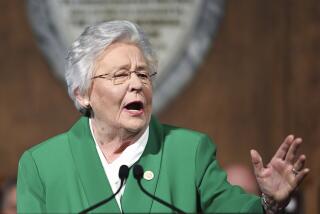Who wants a union? Not Southern autoworkers, it seems
Reporting from Montgomery, Ala. — Deric Golden has what he calls his dream job, fixing small flaws on the sedans being churned out at the Hyundai factory here.
So when two organizers from the United Auto Workers knocked on his apartment door one day, hoping to get him to sign a union card, he quickly sent them packing.
“I told them I didn’t work at the plant,” said Golden, 29. “I just wasn’t interested.”
It’s the same story in town after town along the southern tier of Auto Alley, a corridor that runs north-south along interstates 75 and 65 from Lexington, Ky., to Montgomery.
Foreign automakers — including Honda, Kia, Mercedes-Benz, Nissan, Toyota and Volkswagen — are placing their U.S. factories in this region because of generous state and local incentives and a workforce famously resistant to unions.
Still, this is the region that Bob King, president of the UAW, calls a key battleground that could alter the future of the industry’s labor movement. And it’s workers like Golden whom the union must win over.
“It is critically important for our membership to organize those facilities to keep the companies where we already represent workers competitive,” King said. “We need to make sure that companies compete on the basis of engineering, design, quality and innovation — not on who can pay their workers the least.”
The Southern battle is shaping up at a time when the labor movement is facing new assaults from anti-labor governors and legislatures in traditionally friendly environs such as Wisconsin and the industrial Midwest. King is hoping his pitch — that the union is the defender of middle-class jobs and upward mobility — will resonate with the rank and file.
“We keep putting more taxes and lower wages on the people who are working in this nation and keep giving tax breaks to the wealthy,” he said. “And that will destroy our democracy.”
The union’s membership has been shrinking across the country, hurt by the recession, bankruptcies by General Motors and Chrysler and an industrywide restructuring that has closed dozens of factories with UAW contracts.
Since 2007, the number of auto industry workers belonging to the union has plunged 46% to just 185,522 from more than 345,407.
Plants in the South are churning out more of the nation’s supply of new vehicles. They now account for about half of all vehicle manufacturing in the U.S., yet none of the factories operated by the foreign automakers in the region has union workers.
The Detroit-based UAW could see its role in setting wages and benefits for the industry severely diminish unless it gains members at those plants, King said.
Wages vary by company and geographic region, making exact comparisons difficult. Average labor costs — wages and benefits — for the unionized Detroit automakers and nonunion Toyota’s U.S. plants are about the same at $55 an hour, according to the Center for Automotive Research. But the rest pay less; nonunion Honda pays about $50 an hour. Nissan, Hyundai and Kia are at about $45.
Since the 1950s, the UAW has “played a central role in producing a growing and vibrant American middle class,” said Harley Shaiken, a UC Berkeley professor and labor expert. The wages and benefits it exacted from the Detroit automakers in the second half of the 20th century set a pattern for manufacturing wages nationwide, he said.
Though much smaller now, the union remains a force — and King has moved to expand its reach by courting new political constituencies such as environmentalists and human-rights activists as well as new industries.
But the UAW is having trouble making its case to workers who have an intense loyalty to the automakers who brought high-paying blue-collar employment to these small towns and cities starved for jobs.
“I don’t want to give any more pieces of the pie to anyone else. I need it for myself,” said Kevin Carroll of La Grange, Ga., who was unemployed when hired by Kia Motors Manufacturing last year.
The West Point, Ga., Kia plant, which opened in 2009, has had more than 100,000 applications for just 2,100 positions.
Charles Miller of Powder Springs, Ga., had worked for an industrial parts manufacturer that for the 18 months before he joined Kia in August had put its workers on a one-week furlough every month. He said the factory job he landed painting Kia Sorrento SUVs had better pay and benefits even without the furloughs, greatly improving his finances.
“We have good communication with management here. Why would you need a union?” he asked. “The only time a union shows up is to collect dues or at election time.”
Sentiments like these emphasize the magnitude of the challenge the UAW faces.
“It is pretty hard to see the union breaking through,” said James Rubenstein, an auto industry analyst and geography professor at Miami University in Oxford, Ohio. “It would have to be a plant where the working conditions have gotten so bad that people are up in arms and furious with management. There really aren’t any bad factories anymore. These plants are now warm and fuzzy.”
King’s organizers have been hitting the pavement as he tries to persuade companies to allow the union to make its case directly to the workers.
King wants Hyundai and the other foreign companies making cars in the South to agree to a set of organizing principles for “fair elections” that would allow the union to make its pitch to employees in a setting that’s free of workplace “tension, fear and discord.”
His proposal includes having the union and management address workers at the same time and in the same manner, whether it is posting notices in the factories or having meetings of similar duration.
“All we want is a fair process, and whatever the workers decide will be the decision. If they decide they don’t want to be in the union, we will accept that and move on,” King said.
The automakers haven’t responded publicly to the UAW’s proposal for a set of principles outside of what is already required by labor law. And they were reluctant to talk about the union’s efforts.
“Our employees will have a voice in the company, and our people will decide for themselves what their representation looks like,” said Hans-Herbert Jagla, the executive vice president of human resources at Volkswagen’s factory in Chattanooga, Tenn.
Similarly, J. Randy Jackson, the director of human resources at the Kia plant, said union representation was for “our team members to decide.”
So far, the UAW has had little success. The union lost elections at the Nissan plant in Smyrna, Tenn.
“The UAW has to have a reason to come inside the company. Nissan doesn’t give them one,” said Nish Peters, who has built cars at Nissan’s factory for the last 17 years. “I don’t need someone talking to the boss for me.”
More to Read
Inside the business of entertainment
The Wide Shot brings you news, analysis and insights on everything from streaming wars to production — and what it all means for the future.
You may occasionally receive promotional content from the Los Angeles Times.











